Jupiter rocks; Carmen sags
March 8, 2007
____________________________________________________________

The Jupiter String QuartetThe Washington Post 3/08/07: Is anything more daunting than starting a string quartet? The field is crowded, the competition intense, and the bar keeps rising to pitiless heights of virtuosity. But the young members of the Boston-based Jupiter String Quartet have been racking up an impressive string of prizes and displaying -- as they did Tuesday night at the Terrace Theater -- razor-edged ensemble work and imaginative depth beyond their years.
The evening opened with the fourth of Franz Joseph Haydn's Op. 20 "Sun" quartets, in D -- a quietly intelligent work full of Haydn's interplay of wit and elegant pathos. The Jupiter turned in a nuanced reading, displaying an almost organic unity in their playing.
But it was Bela Bartok's String Quartet No. 3 that really showed what this group can do. It's a work of startling power that still sounds audacious after more than 70 years, and the Jupiter tore into it with sweep and almost feral intensity, building a controlled explosion that never let up for an instant – a gripping and brilliantly-colored performance that left scorch marks on the brain.
It takes a major piece to follow Bartok, so the Jupiter returned after intermission with Beethoven's extraordinary Quartet in B-flat, Op. 130. After a rambling start, things quickly tightened up, and by the harrowing "Grosse Fuge" that closes the work it was clear that the Jupiter was back in full cry -- fearless, relentlessly powerful music-making by one of the most promising young quartets around.
______________________________________________________________

Georges BizetThe Washington Post 3/08/07: Georges Bizet's tragic opera "Carmen" may be one of the most compelling stories of passion ever told. When the naive Spanish soldier Don Jose falls in love with the free-spirited and irresistible Carmen, he drags them both into a whirlpool of love, violence, treachery and death. It's a daring exploration of the wilds of the human heart, and it's still intensely fascinating.
Director Nick Olcott has, unfortunately, set out to change all that. In a stripped-down version for the In Series (running this week at GALA Hispanic Theatre) Olcott rewrote the drama to focus on the collision of Carmen's "need for freedom" (as he puts it) with Don Jose's "need for control" and "drive to win."
Uh-oh. If that sounds like a squishy exercise in gender politics, it should. Olcott's earnest approach drains away much of the tragedy's complexity and dramatic impact, replacing it with a bland tale of "boy meets girl, boy loses girl, boy acts out in an inappropriate manner." There's little here to engage the adult mind; rather than a tragic lover, we get Don Jose in an extended fit of pique, and Carmen's untamable wildness has been replaced with some mild brow-furrowing over, one imagines, her "needs."
Mezzo-soprano Anamer Castrello sang the title role with warmth and real beauty, though she lacked the ferocity and sensuality to be a convincing Carmen. Peter Burroughs brought his fine light tenor to the role of Don Jose, there were excellent turns by all the supporting singers, and Alisa Bernstein and Lourdes Elias kicked in some fiery flamenco dancing.
Credit for keeping the drama moving goes largely to pianist Carlos Rodriguez, who wrote the orchestral transcription and provided enthusiastic if sometimes approximate accompaniment.
Marin, Savion and the BSO at Strathmore
March 3, 2007
_________________________________________________________

Savion GloverThe Washington Post 3/5/07: Marin Alsop, flirting once again with the notion that symphony concerts can be (shudder) fun, brought a hugely entertaining "celebration of dance" to the Music Center at Strathmore on Friday night -- part of the Baltimore Symphony Orchestra's "Symphony With a Twist" series.
Actually, it was more a "celebration of Savion Glover" -- the tap-dancing phenom who's 50 percent rubber and 50 percent exuberant grin. As the BSO launched into Duke Ellington's jazz-classical suite "The River," Glover mounted an amplified platform and began to tap, turning the work into a sort of concerto for percussion and orchestra.
Glover is almost scarily gifted -- he moves with a spontaneous and utterly natural fluidity, and appears powered by the sheer joy of being alive. And what came out was a solo so detailed, so colorful and so full of the complex rhythms of the human body that it almost overwhelmed the orchestra itself -- a force-of-nature performance that brought down the house.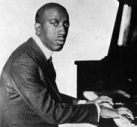
James P. JohnsonThe rest of the program wasn't quite as spectacular, but offered jazzy fare like James P. Johnson's "Victory Stride," which rolled and strutted with propulsive rhythm and featured fine solos from half a dozen BSO players. Dominick Argento's "Tango" from "The Dream of Valentino" was given a lush but languid performance that, for all its subtle colors, lacked the erotic tension that makes a tango tango. But Leonard Bernstein's Symphonic Dances from "West Side Story" was a surprising pleasure -- like seeing old friends in an unfamiliar setting. The orchestrations may have been a bit froufrou at times ("Maria" played pizzicato?), but the whole thing had a retro '60s charm that you had to love.
_________________________________________________________
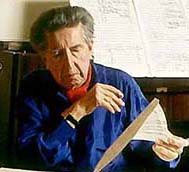
Henri DutilleuxLots of other good stuff this weekend, too: the Post's Mark Estren says the Leipzig Gewandhaus Orchestra (with Yundi Li in Liszt's Piano Concerto No. 1), played "as precisely as a chamber group, but with rafter-rattling power when needed" in a mostly-Strauss program (read the review here); Cecelia Porter heard the Aron Quartett's "inspiring" performance of Schoenberg, Haydn and Korngold at the Library of Congress (read here); and Tim Page has a lengthy review of an amazing program by the Left Bank Quartet that included Messiaen's "Quartet for the End of Time" (with the NSO's Loren Kitt on clarinet), a "joyfully weird" piece by Heinrich Biber called "The Assumption of the Virgin"; and Henri Dutilleux's brilliant string quartet "Ainsi la nuit." Page was not so enthusiastic about the Dutilleux, but it's a work I'm almost magnetically drawn to -- a stunning, perfect piece of modernist writing that ranks up there with the top quartets of the 20th Century. IMHO, of course.
Joyce DiDonato at the Terrace
March 1, 2007
____________________________________________
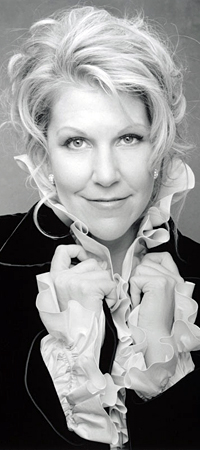
Joyce DiDonatoThe Washington Post 3/1/07: The young mezzo Joyce DiDonato has been stirring things up on the operatic stage for the last few years, winning hearts and minds for her dramatic depth as much as for her remarkable, multifaceted voice. So it was a real pleasure to hear her Tuesday in the relatively intimate Kennedy Center Terrace Theater, where she presented an unusually captivating recital that ranged from lullabies to scorched-earth coloratura.
Accompanied by the fine pianist Julius Drake, DiDonato opened with five songs by Georges Bizet. It was an inspired beginning; these songs are lyrical almost to a fault, and she delivered finely calibrated interpretations, precisely balanced between full-voiced richness and transparent delicacy.
But that was mere lead-in to the blockbuster of the evening, Gioachino Rossini's solo cantata "Giovanna d'Arco." It's a dazzling tour de force, almost a catalogue of coloratura technique. And while it may sound a bit overcooked to modern ears, DiDonato carved a brilliant and explosive drama out of it, repeatedly building the tension, drawing back and building again into a final climax -- a performance as psychologically astute as it was powerful.
The second half of the program was given over to Spanish music, including five darkly poetic songs by Enrique Granados (known in his homeland as "the Spanish Schubert") and seven songs by Manuel de Falla. DiDonato has taken a particular interest in this music, and it's well suited for her; she brought a growling wit to "El Paño Moruno" and a convincing Iberian pathos to "Asturiana," before closing the evening with three sophisticated, beguiling songs by the much-too-little-known Xavier Montsalvatge.
Alsop's First BSO Season Unveiled
February 28, 2007
_____________________________________________________________
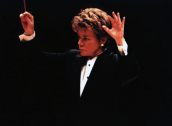
Marin AlsopIncoming Baltimore Symphony music director Marin Alsop announced the orchestra's 2006-7 season yesterday, and -- as expected -- it looks like there's much imaginative and exciting music on the way. Major new works by eleven living composers will be featured, including Joan Tower, Aaron Jay Kernis, Steven Mackey, John Adams, Tan Dun, James MacMillan, Thomas Ades and HK Gruber.
"It is an infinitely more thought-provoking season than the one the National Symphony Orchestra offered for 2006-07, which has been much criticized for its timidity and reiteration of standard repertory," says The Washington Post's Tim Page in a story today. Page also reports that the season will kick off with a gala concert on September 15 featuring "a cast of hundreds."
Just as noteworthy is the welcome decision to cut subscription ticket prices to $25. Tim Smith at The Baltimore Sun has a good overview of the BSO's efforts to bring in more listeners with "cheap seats, conversations with high-profile composers and programming that includes a CSI-style forensics exploration of Beethoven."
Mason Bates' "Liquid Interface" at the Kennedy Center
February 25, 2007
_________________________________________________________________________
 We went down to the Kennedy Center last night to hear Mason Bates' "Liquid Interface" -- a new work that uses electronica and a beefed-up orchestra to explore (in the composer's words) "water in all its forms." And Bates proved himself an impressive talent. The piece is shot through with originality and sonic imagination, and though it may not break much new ground harmonically, its striking colors and pulse-driven flow made it an always-interesting listen.
We went down to the Kennedy Center last night to hear Mason Bates' "Liquid Interface" -- a new work that uses electronica and a beefed-up orchestra to explore (in the composer's words) "water in all its forms." And Bates proved himself an impressive talent. The piece is shot through with originality and sonic imagination, and though it may not break much new ground harmonically, its striking colors and pulse-driven flow made it an always-interesting listen.
Working a MacBook Pro and and an Akai electric drumpad from a podium at stage left, the composer performed the electronic elements of the piece himself, while conductor Leonard Slatkin ran the National Symphony Orchestra through its paces.
The concept behind "Liquid Interface" is dramatic, to say the least: The Earth's water changes as the planet heats up, unleashing more and more of its power until a huge hurricane erupts, washing everything into the ocean and eventually submerging the planet. (I'm paraphrasing Bates' program notes.) It's a great conceit for a piece, but we came away wishing that Bates -- given his obvious skill and imagination -- had gotten more out of the material.  To these ears, the second of the four movements was the most successful; Bates used sampled water sounds as the basic raw material for his electronica, blending the sounds into an orchestral water dance that was an absolute tour-de-force. The synthesis of orchestra and computer was seamless, the writing gorgeous and intensely musical, and the realization of the water-into-sound idea brilliantly done -- in short, some of the most impressive new writing you'll hear anywhere.
To these ears, the second of the four movements was the most successful; Bates used sampled water sounds as the basic raw material for his electronica, blending the sounds into an orchestral water dance that was an absolute tour-de-force. The synthesis of orchestra and computer was seamless, the writing gorgeous and intensely musical, and the realization of the water-into-sound idea brilliantly done -- in short, some of the most impressive new writing you'll hear anywhere.
But the drama seemed to sag after that promising beginning. The climactic "electronic hurricane" of the third movement was rather tame, as electronic hurricanes go. Entering with convincing menace, it quickly got all shy about, you know, wiping out life on the planet. So it did it as politely as it could.
Similarly, the aftermath of the storm -- when the music evokes a planet drowned in water -- was wonderfully done, but was over almost before it started. Too bad -- the image of a ravaged world "swept into the muffled depths of the ocean" is seriously compelling, and it would have been fascinating to hear what Bates could do with such an unusual, dramatic and emotionally-charged landscape.
After this quasi-biblical flood, the waters recede, the planet is reborn, and Bates uses the final movement to evoke a serene world. It's beautiful writing, and a beautiful world. And yet, coming out of this cataclysmic flood, somehow not quite ... enough. You feel hungry for a resolution beyond just optimism -- some deeper exploration of disaster, transcendence and rebirth. Instead, you get mere tranquility, and the piece ends with a graceful evaporation of sound. Lovely, certainly -- but frustrating in a work with such a powerful dramatic arc.
That said, this is still a fne and extremely enjoyable piece, and received a long ovation -- kudos to Slatkin & Co for commissioning it. Mason Bates just turned 30 last month, and if "Liquid Interface" is any indication, he's just at the beginning of a fascinating career.
"Life" -- A Glass Act at Strathmore
By Stephen Brookes • The Washington Post • February 2, 2007
_______________________________________________________________________________________
Walking on a beach about seven years ago, Frans Lanting had an epiphany. The National Geographic photographer was shooting pictures of horseshoe crabs crawling out of the ocean, and suddenly realized that the creatures hadn't changed in hundreds of millions of years; he was looking directly into the distant origins of life.
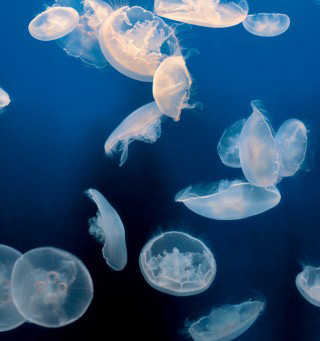 That moment set Lanting on an epic, six-year photographic journey around the world "with the simple idea," as he puts it, "of looking for the past in the present." The final result -- which premiered last summer in California -- was a spectacular, hour-long exploration of the evolution of life on earth, with some 200 of Lanting's most vivid images set to a score by the minimalist composer Philip Glass.
That moment set Lanting on an epic, six-year photographic journey around the world "with the simple idea," as he puts it, "of looking for the past in the present." The final result -- which premiered last summer in California -- was a spectacular, hour-long exploration of the evolution of life on earth, with some 200 of Lanting's most vivid images set to a score by the minimalist composer Philip Glass.
The East Coast got its first look at "Life: A Journey Through Time" at the Music Center at Strathmore on Thursday night, when the Baltimore Symphony Orchestra presented it as part of the Explorer series. The project is a feast for both eyes and ears -- Lanting's majestic photographs dance lightly across a huge screen over the orchestra, while some of Glass's most elegant music pulses underneath. It's a celebration of nature in all its glory -- from modest lichens to vast, erupting volcanoes.
And yet, while it's a completely enjoyable way to spend an hour, "Life" doesn't really fulfill the ambitious promise of its title. It drifts through the eons, checking off points on the timeline but telling no particular story, connecting no interesting dots and offering no new insights, and the images seem chosen more for their beauty than anything else. As visual entertainment, it's lovely. As a serious meditation on evolution, it disappoints.
To be fair, the production was never intended as a Discovery Channel special. Lanting is a gifted nature photographer, and his images (especially on this scale) are spellbinding -- scorpions preparing to strike, hulking stromatolites stretching into a primal dawn, cheetahs charging across the African plain. And it's worth the price of admission just to see a 40-foot jellyfish float lovingly over conductor Marin Alsop's head.
It was also good to hear the music of Glass played by the BSO. Baltimore is Glass's home town, yet he's been shamefully ignored by the orchestra -- though that may be about to change. Alsop, the incoming BSO music director, understands Glass's music deeply (she once played in the Philip Glass Ensemble), and her handling of the score was beautifully detailed and evocative -- a stunning performance sure to whet concertgoers' appetites.
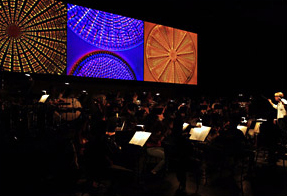
Alsop conducting the premiereAnd it was an inspired choice to pick Glass for this project; his short, cellular motifs slowly replicate, transform and blend their musical DNA to form greater and more complex shapes -- all with the implacable industriousness of evolution itself. The score (actually a pastiche of previous works, stitched together and orchestrated by Michael Riesman) kept "Life" moving forward smoothly, and sat fatly in the ears.
Another Glass work, the 1995 Concerto for Saxophone Quartet, opened the program. And whether you think Glass writes music of transcendent poetry or just cranks out tedious nonsense for slow thinkers, the Concerto is one of his more charming works, with an engaging blend of soaring lyricism and jazzy, metropolitan thrust. The Capitol Quartet brought the work alive with personality, enthusiasm and warmth -- matched fully by Alsop and the BSO players.
____________________________________________________
Note: the program will be repeated Saturday 2/24 at 8 pm, and Sunday 2/25 at 3 pm, at Meyerhoff Symphony Hall in Baltimore. Lanting will also be talking about his work at the National Geographic Society in DC on Tuesday 2/27.
The Baltimore Sun's Tim Smith was also at Thursday's performance; check out his review here.
Bates Premiere -- Outshining Mendelssohn?
February 23, 2007
__________________________________________________________________
Mason Bates' new electronica-orchestra-blending "Liquid Interface" premiered at the Kennedy Center last night, played by the National Symphony Orchestra under Leonard Slatkin. Couldn't be there (had to be at Strathmore for Frans Lanting's "Life: A Journey Through Time") but the Post's Andrew Lindemann Malone caught it, and says the work "surpassed in sheer sonic beauty even the works by Mendelssohn and Tchaikovsky that rounded out the program." Not bad. Gets another performance this afternoon and Saturday at 8 pm, so check it out if you can. Click here for the review.

